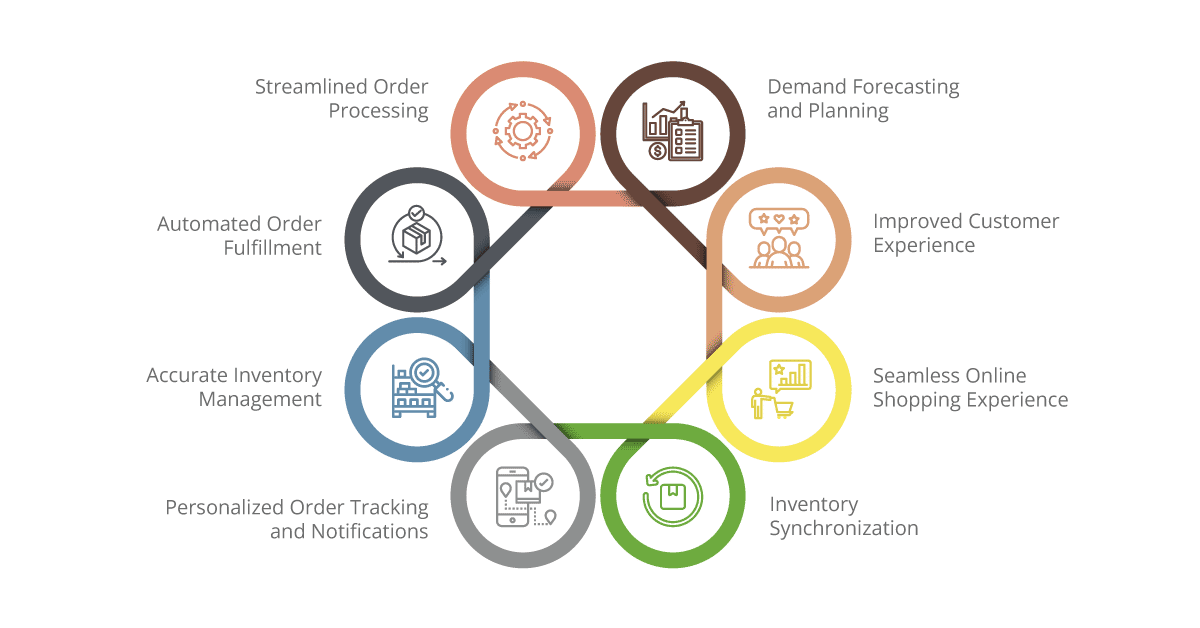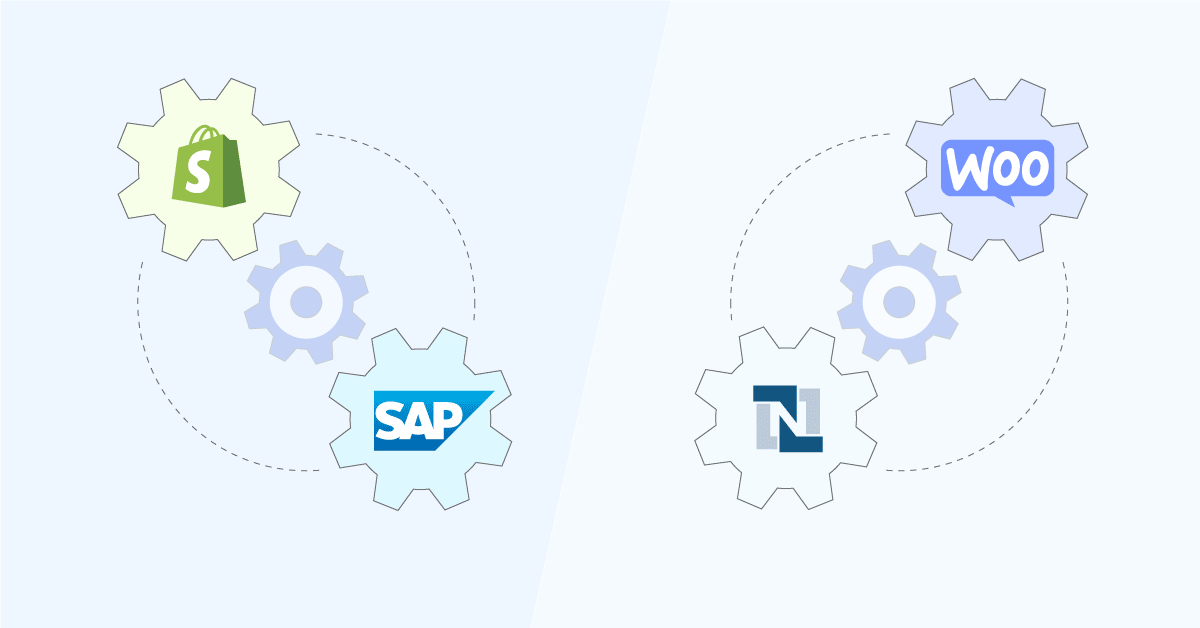eCommerce platforms have revolutionized the way businesses sell products and services online. These platforms enable companies to reach a global audience, increase sales, and provide a convenient shopping experience for customers.
On the other hand, Enterprise Resource Planning (ERP) systems play a crucial role in managing various aspects of a business, including inventory, finance, and order fulfillment. Integrating E-commerce platforms with ERP systems has become a necessity for businesses seeking to optimize their order management processes and deliver a seamless customer experience.
Aonflow iPaaS – Free for First 3 Months!
Build and run up to 1,500 transactions monthly with no cost. No payment info needed!
Challenges in Order Management
Siloed data and manual processes
Without integration, E-commerce platforms and ERP systems often operate in isolation, leading to manual data entry and repetitive tasks. This not only wastes time but also increases the risk of errors and discrepancies in order information.
Inefficient inventory management
Inaccurate inventory data can lead to stockouts, overstocking, and fulfillment delays. Disconnected systems make it difficult to maintain real-time visibility into inventory levels and efficiently manage stock across multiple channels.
Lack of real-time visibility
E-commerce businesses need instant access to accurate order information, including customer details, product availability, and shipping status. Without integration, delays in data synchronization can result in outdated information and poor decision-making.
Inconsistent customer experience
Customers expect a seamless experience from browsing products to placing orders and receiving them. Inconsistent information across E-commerce platforms and ERP systems can lead to order discrepancies, delays in order fulfillment, and dissatisfied customers.
How Integration Enhances Order Management
Streamlined order processing
Integration enables real-time updates between E-commerce platforms and ERP systems, allowing businesses to streamline order processing. For example, when a customer places an order, the integration automatically updates the ERP system with the order details, initiates order fulfillment, and provides the customer with real-time updates on the order status.
Real-time order updates
Integration ensures that order information is synchronized instantaneously between the E-commerce platform and the ERP system. This means that as soon as a customer places an order, the ERP system is immediately updated with the order details, such as the products purchased, quantity, and customer information. This real-time synchronization eliminates the need for manual data entry and minimizes the risk of errors.
Automated order fulfillment
With integration, the order fulfillment process can be automated. Once an order is received, the integration triggers the necessary workflows in the ERP system to prepare the order for shipping. This includes generating picking lists, packing slips, and shipping labels. By automating these processes, businesses can improve efficiency and reduce the time it takes to fulfill orders, resulting in faster delivery times.
Accurate inventory management
Integration eliminates manual inventory tracking and enables automatic synchronization between E-commerce platforms and ERP systems. This ensures accurate and up-to-date inventory information, minimizing stockouts and overstocking. Integration also enables demand forecasting and planning, helping businesses optimize inventory levels based on historical data and sales trends.
Inventory synchronization
The integration between E-commerce platforms and ERP systems ensures that inventory data is constantly synchronized. Any changes in inventory levels, such as products being sold, returned, or restocked, are immediately updated in both systems. This real-time synchronization provides businesses with accurate inventory information, reducing the risk of stockouts or overselling.
Demand forecasting and planning
By leveraging integration, businesses can utilize the combined data from E-commerce platforms and ERP systems to perform demand forecasting and planning. This involves analyzing historical sales data, customer trends, and market conditions to predict future demand. With accurate demand forecasting, businesses can optimize their inventory levels, ensuring they have enough stock to meet customer demands without excessive carrying costs.
Improved customer experience
Integration creates a seamless online shopping experience for customers. They can browse products, check stock availability, and place orders without encountering discrepancies or delays. Integration also enables personalized order tracking and notifications, keeping customers informed about their order status and estimated delivery dates.
Seamless online shopping experience
Integration allows for a seamless experience for customers across E-commerce platforms and ERP systems. Product information, pricing, and stock availability are consistent and up to date, regardless of the platform the customer is using. This consistency enhances the overall shopping experience and instills confidence in customers that the information they see is accurate and reliable.
Personalized order tracking and notifications
Integration enables businesses to provide personalized order tracking and notifications to customers. Customers can receive updates on their order status, shipping information, and estimated delivery dates via email, SMS, or through their customer account on the E-commerce platform. This level of transparency and communication enhances the customer experience and builds trust between businesses and their customers.
Examples and Use Cases
Example 1: Integrating Shopify with SAP ERP
Shopify, a popular E-commerce platform, can be integrated with SAP ERP to streamline order management.
The integration ensures real-time synchronization of orders, inventory, and customer information between Shopify and SAP ERP.
When a customer places an order on Shopify, the integration automatically updates the SAP ERP system, triggers order fulfillment processes, and provides customers with order tracking details.
Example 2: Integrating WooCommerce with Oracle NetSuite
WooCommerce, a widely used E-commerce platform, can be integrated with Oracle NetSuite, a comprehensive ERP system.
The integration enables real-time synchronization of orders, inventory, and financial data between WooCommerce and Oracle NetSuite.
Businesses can leverage the integration to automate order processing, streamline inventory management, and gain comprehensive visibility into their E-commerce operations.
Use case: Enhancing order management for a growing online retailer
A growing online retailer experiencing inefficiencies in order management integrates their E-commerce platform with their ERP system.
The integration enables seamless order processing, accurate inventory management, and real-time updates for customers.
The retailer experiences significant improvements in order fulfillment efficiency, inventory accuracy, and customer satisfaction.
Aonflow is the leading integration platform.
You can kick-start by integrating your first-ever workflow in just a matter of minutes.
Best Practices for Successful Integration
Choose the right iPaaS solution
When integrating E-commerce platforms with ERP systems, selecting the appropriate Integration Platform as a Service (iPaaS) solution is crucial. Look for an iPaaS solution that specifically supports the E-commerce platform and ERP system you are using. Consider factors such as compatibility, scalability, security features, and the availability of pre-built connectors or APIs for seamless integration. It is important to choose an iPaaS solution that can handle the complexity of your integration requirements and offers the necessary customization options.
Define data mapping and synchronization rules
Data mapping involves establishing clear rules on how data should flow between the E-commerce platform and the ERP system. Determine which data fields from the E-commerce platform correspond to the fields in the ERP system. Create a data mapping document that outlines these connections and ensures that the data is synchronized accurately and consistently between the systems. This step is crucial to maintain data integrity and avoid any confusion or discrepancies during the integration process.
Test and validate the integration
Thoroughly testing the integration before going live is essential to identify and resolve any potential issues. Create a comprehensive testing plan that includes scenarios such as order placement, inventory updates, and data synchronization. Conduct various test cases to simulate real-life situations and ensure that the integration performs as expected. Validate the data flow between the E-commerce platform and ERP system, verifying that the information is accurately transferred and updated in real time. Address any bugs or discrepancies discovered during the testing phase to ensure a smooth and error-free integration process.
Monitor and optimize performance
Once the integration is live, ongoing monitoring and optimization are crucial for maintaining its performance and efficiency. Monitor key metrics such as data synchronization times, response times, error rates, and system performance to identify any bottlenecks or areas for improvement. Regularly review the integration logs and error reports to address any issues promptly. Continuously optimize the integration by fine-tuning data synchronization rules, improving data validation processes, and optimizing workflows. Stay updated with new releases or updates from the iPaaS solution provider to take advantage of enhanced features and bug fixes.
Implement robust security measures
Integration between E-commerce platforms and ERP systems involves the transfer of sensitive customer data, financial information, and inventory details. It is vital to prioritize data security throughout the integration process. Implement robust security measures such as encryption, secure APIs, and authentication protocols to safeguard data during transmission and storage. Regularly update and patch all systems involved in the integration to protect against potential vulnerabilities. Adhere to industry compliance standards and regulations to ensure data privacy and security.
Provide comprehensive documentation and support
Create detailed documentation outlining the integration process, including step-by-step instructions, data mapping guidelines, and troubleshooting tips. This documentation will serve as a valuable resource for future reference and for training new team members. Additionally, ensure that a support mechanism is in place to address any integration-related issues or questions that may arise. Offer reliable support channels, such as email, ticketing systems, or live chat, to assist users in troubleshooting integration challenges or seeking guidance.
Following these best practices enables businesses to ensure a successful and seamless integration between their E-commerce platforms and ERP systems. A well-planned and executed integration enhances order management processes, optimizes inventory management, and delivers an exceptional customer experience.
Conclusion
Integrating E-commerce platforms with ERP systems is vital for enhancing order management processes in today’s competitive business landscape. By streamlining order processing, improving inventory management, and delivering a seamless customer experience, businesses can achieve operational efficiency, reduce costs, and increase customer satisfaction.
As E-commerce and ERP systems continue to evolve, integration will play an even more significant role in shaping the future of online retail. Embracing integration now can give businesses a competitive edge and position them for success in the years to come.
Aonflow iPaaS – Free for First 3 Months!
Build and run up to 1,500 transactions monthly with no cost. No payment info needed!


